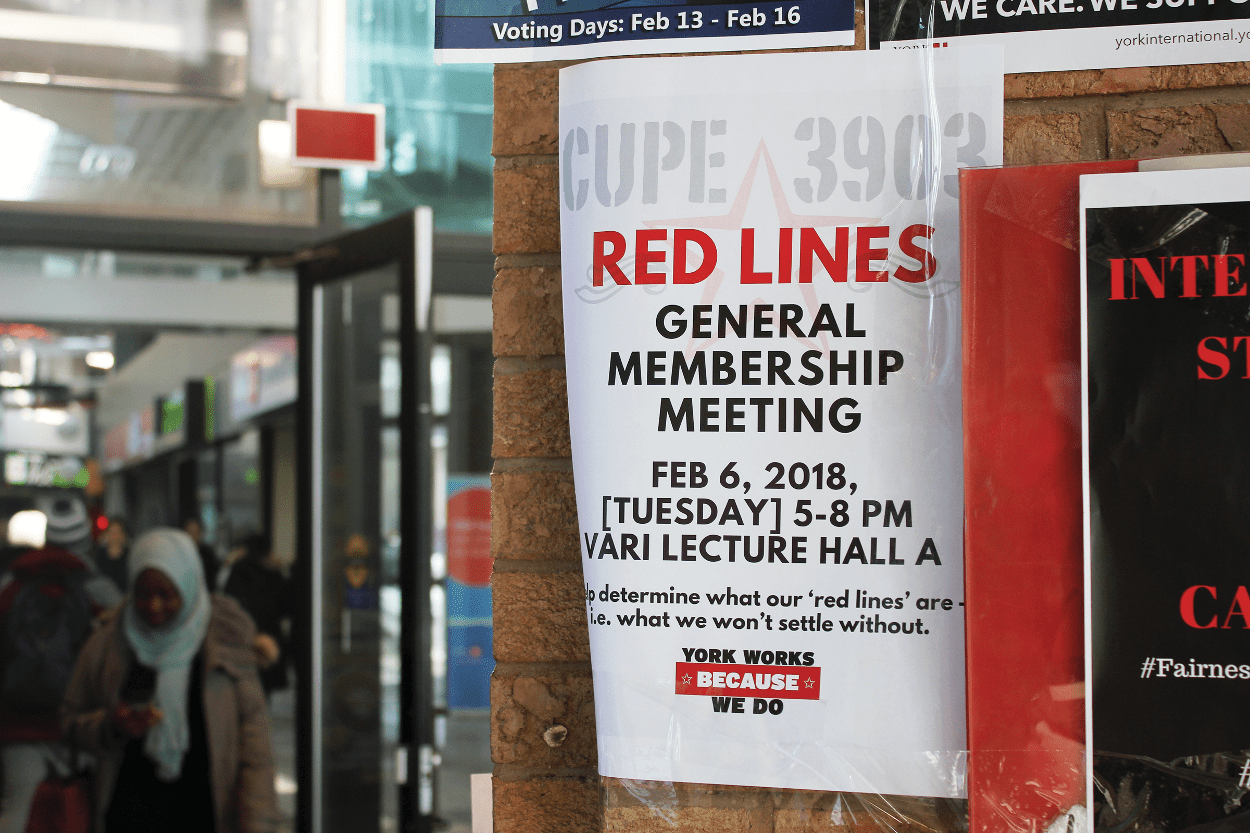Dennis Bayazitov | Assistant News Editor
Featured image: CUPE 3903 will move closer to striking if unsatisfied with York’s offer. | Basma Elbahnasawy
The Canadian Union of Public Employees (CUPE)—York local 3903—has met with York for three bargaining meetings since January 29. During that time, in hopes of putting more pressure on York to reach a satisfactory Collective Bargaining Agreement (CBA), the Union has set a tentative deadline for March 2, at which point York will have to present its final offer.
Despite 85 per cent of participating Union members voting in favour of a strike during the mandate vote, which was finalized on January 26, bargaining has not taken a more favourable direction since the January 29 meeting, says Lisa Nasr, Unit 1 bargaining team member and spokesperson.
“February 1 seemed a bit more promising, but this is a conversation we’ve been having since October, so I can’t really say whether or not that can count for us as moving forward.”
The forefront points of negotiation remain: job security (particularly job conversions), Unit 1 funding for graduate students, and equity proposals to address systemic inequalities like sexism or racism, and to institute measures to ensure York is accountable for their hiring processes.
“Last Thursday, we met through the conciliator for most of the day and asked for some counters on job security proposals,” Nasr says. “They’ve provided their own proposals for conversions, but we’ve presented 27 proposals that deal with job security, and the rest have sort of been ignored.”
Another CUPE 3903 bargaining spokesperson, Julian Arend, says the Union and York had agreed on some non-monetary issues. “York was at first refusing to even tell teaching assistants whether they were accruing seniority for their work or not. They’ve been going through six years of not knowing what’s going on,” he says.
“They finally agreed to say yes and put it on the contract, a ‘major’ move by them.”
In addition, CUPE 3903 agreed on language tabled by the employer for workers to be allowed to see their work histories online, as well as implementing an online system for job postings.
“Those are the first things getting agreed to,” Arend says. “But they’re not the actual nuts and bolts of our proposals.”
The spokespersons affirm the Union has booked more dates with the conciliator in February, at a higher frequency than in January.
“We’d really like to see movement this month,” says Nasr.
Neither side has requested a No Board Report yet—which can be filed at any point—and would require both sides and the conciliator to agree that negotiating a suitable agreement at the table is no longer possible.
A No Board Report is a necessary request to make if the Union wants to begin the process of a legal strike.
Since the start of negotiations in October, CUPE 3903 has not accepted York’s offer to go to third-party arbitration. “We want to emphasize we work through a conciliator,” Nasr says. “If the purpose of going to arbitration is to bring in a third-party that will help negotiations move along, we have been in that process since the beginning of January.”
CUPE 3903 has not refused the option, either.
CUPE 3903 believes hiring Simon Mortimer, York’s “union-busting lawyer”—as they claim—“has not helped the process, as the lawyer is new to the environment. He does not have the kind of familiarity with the kind of agreements that is necessary to have some of these discussions,” adds Nasr. “Probably one of our biggest problems is that we feel like we are explaining things that already exist in the CBA to people who aren’t familiar with it.”
Arend has been present for several bargaining rounds and helped negotiate two collective agreements. With this round, he claims York’s “tactics are their usual tactics—stalling.
“They stall until the last possible minute. There’s usually almost no movement until a strike mandate vote, and then there’s sometimes some movement, depending on what their priorities are.”
CUPE 3903 hosted a “Red Lines” General Membership Meeting in Vari Hall on Tuesday evening to open the floor to the membership and seek their input for what is believed to be the most important aspects to include in the final offer.
“People were very upset about job security,” says Nasr. “There was some talk of Fair Jobs and Fair Work Act (Bill 148); what they’re looking for is equal pay for equal work, and so there was a large discussion around our job security proposals, and actually not letting York walk away from this table without seeing something substantive for our job security proposals.”
Nasr reports the Union had presented York with 27 proposals on job security, with one of them related to conversions, which they responded to.
Other areas members were concerned with were the health benefits package and increases to child care funds.
Once an offer is presented to CUPE 3903, the membership will decide by ballot vote, unit by unit, whether they will accept it or not.
Arend notes this process differs from one most other unions use. “Once a strike mandate is given, the executives of the bargaining team determine whether or not to go on strike,” he says. “In our case, we allow democratic process to take over.”
Once the ballots are totaled, the decision is given to the representatives. The executives ratify its membership decision, and announce the union will be on strike the following day—in this case, a Saturday, which will be pushed to Monday March 5.
As we move closer and closer to an early-March strike, both parties maintain that is the last thing they would like to see happen.


